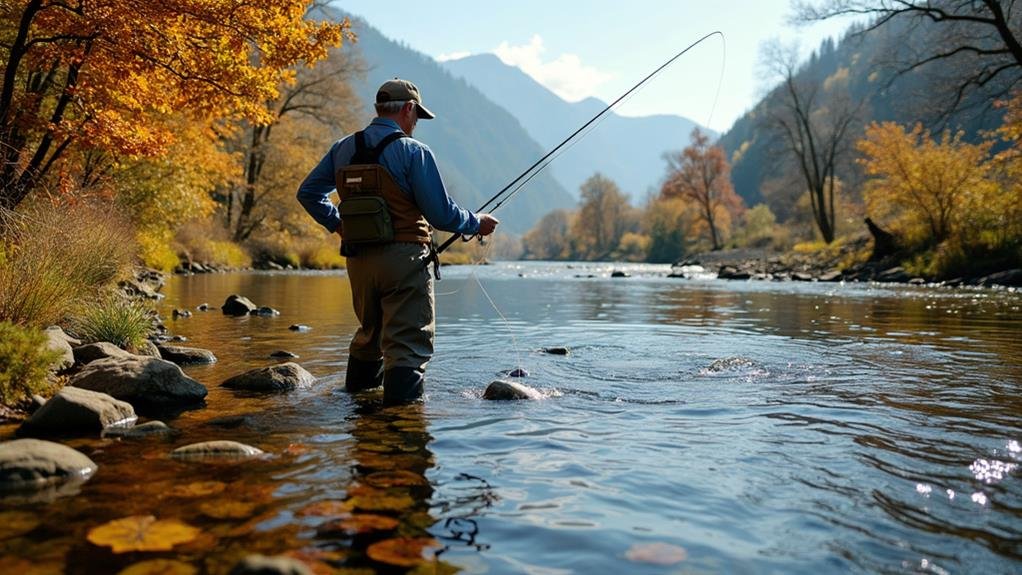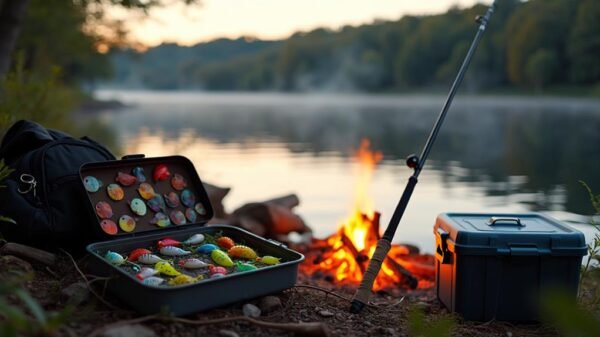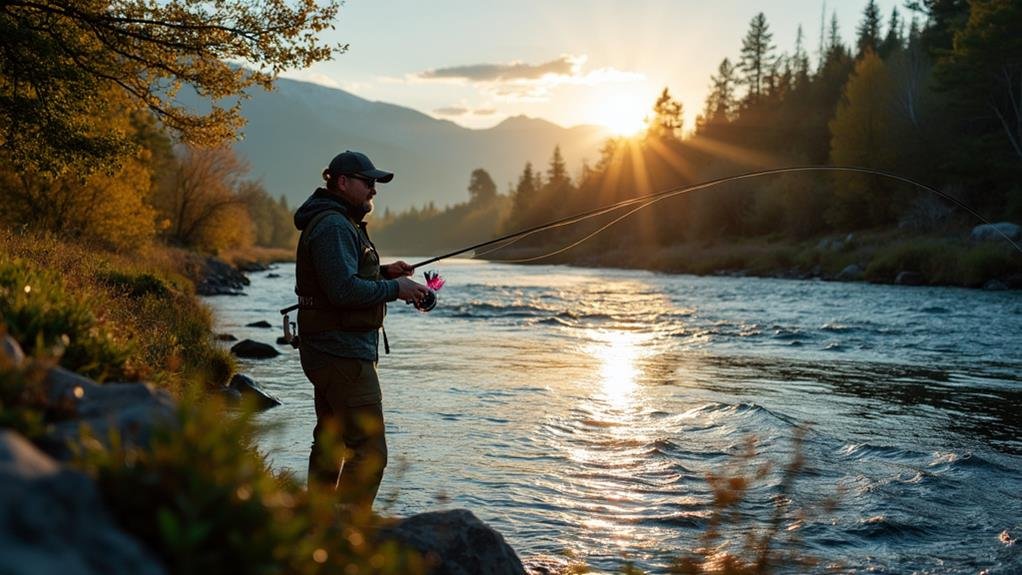To enhance your trout fishing success, start by understanding their behavior—trout seek cooler, deeper waters, especially on sunny days. Choose lightweight gear like a 6- to 7-foot rod paired with a quality reel. Use monofilament line between 4 to 8 pounds, and stock up on hooks sized 8 to 12. Experiment with natural baits like worms or minnows, and consider lures like spinners and spoons for added excitement. Adjust your techniques with the seasons: lighter tackle in spring, deep-water tactics in winter. Perfect your casting for accuracy, and you'll be well on your way to landing that trophy trout! There's much more to discover.
Understanding Trout Behavior
To enhance your trout fishing success, understanding trout behavior in various habitats is essential. Trout, as opportunistic feeders, respond to fluctuations in water temperature, illumination, and food supply. On sunny days, they often retreat to deeper waters or seek refuge under overhanging vegetation to evade predators. When angling in rivers, concentrate on current patterns; trout commonly position themselves behind boulders or in eddies, conserving energy while awaiting prey.
In spring, as temperatures rise, trout exhibit increased activity, migrating to shallower zones for spawning. This period presents an excellent opportunity for anglers to catch them, as seasonal changes significantly influence fish behavior. During winter, trout slow down, showing less inclination to pursue fast-moving lures. In these conditions, a slow presentation using natural baits like nightcrawlers or minnows proves effective. Additionally, monitor weather patterns; light rain can dislodge insects, prompting trout to feed more actively.
Recognizing these seasonal patterns is crucial. In spring, as water warms, trout move into shallower regions to spawn, offering anglers prime opportunities for successful catches. By adapting your strategies based on these behavioral insights, you can significantly improve your odds of landing that coveted trout. Embrace the thrill of the outdoors, and let your knowledge of trout behavior steer your fishing expeditions.
Choosing the Right Gear

Selecting the appropriate equipment is essential for enhancing your trout angling adventure. Begin with a high-quality fishing rod. A lightweight rod, roughly 6 to 7 feet long, offers improved control and sensitivity. Pair it with a premium reel, such as a Shimano Stradic, which boasts a smooth drag system. This setup simplifies casting and assists in landing those lively trout. Additionally, consider using live bait like nightcrawlers or minnows, which can significantly increase your success rates when targeting trout.
Next, evaluate your fishing line. A monofilament line, such as Berkley's Trilene, in the 4 to 8-pound test category is ideal for trout fishing. It is durable yet fine enough to be less detectable in the water. Be sure to have a variety of hooks, specifically sizes 8 to 12, which are suitable for different bait options.
Don't forget to organize your tackle box! Equip it with split-shot weights, bobbers, and some leader line. Finally, wear polarized sunglasses, like those from Oakley, to reduce glare on the water, making it easier to spot those elusive fish.
Effective Bait and Lures

When it comes to enticing trout, selecting the appropriate bait and lures is crucial. The right choice can significantly enhance your chances of landing these spirited fish. Begin by evaluating the available options in your fishing location. For optimal results, consider utilizing TRUSCEND lifelike fishing lures that mimic realistic movements and produce enticing vibrations. Here are three effective selections to kickstart your fishing experience:
- Natural Bait: Worms, minnows, and leeches are typically irresistible to trout. Their natural motions and scent are often enough to provoke a bite. Ensure you keep them active!
- Spinner Lures: These vibrant lures generate vibrations and flashes in the water, imitating the movements of injured baitfish. Experiment by casting them at various depths and retrieving them at different speeds to discover what attracts the trout.
- Spoon Lures: These metallic lures oscillate as you reel them in, resembling distressed fish. They are particularly effective in deeper waters. Try out various sizes and colors to match the local baitfish population.
Seasonal Fishing Techniques

Understanding seasonal fishing techniques is crucial for boosting your trout catch year-round. Each season introduces distinct conditions that influence trout behavior and feeding habits.
In spring, as river temperatures rise and insects emerge, utilize light tackle and small lures like Mepps spinners. Trout become more active, eagerly pursuing these enticing offerings, particularly during dawn and dusk.
Summer brings warmer conditions, prompting trout to seek cooler, deeper waters. Early mornings or late evenings become prime opportunities. Use brands like Rapala spoons to imitate smaller fish, increasing your chances of a successful catch.
As fall approaches, trout prepare for winter, leading to aggressive feeding. This is the ideal time to deploy larger baits, such as live minnows from reputable suppliers, to attract these fish.
Winter presents a challenge as cold temperatures slow trout activity. Focus on deeper waters and employ live bait or jigs, such as those by Berkley. Patience is essential during this season, as trout become less active and require more time to bite.
Mastering Casting Techniques

Mastering casting techniques can greatly enhance your trout fishing experience. Whether you are a novice or an experienced angler, refining your casting skills can lead to a significant increase in your catch rate. Utilizing high-quality gear, such as PowerPro fishing snap swivels, can elevate your efficiency while fishing. These swivels facilitate quick lure swaps, ensuring you always have the most effective option for attracting trout. Here are three essential tips to improve your casting abilities:
- Refine Your Grip: Hold the fishing rod firmly, but maintain a relaxed grip. A soft hold improves control and precision.
- Optimize Your Stance: Position your feet shoulder-width apart, with slightly bent knees. This solid foundation allows you to generate power and accuracy in your cast.
- Execute the Right Motion: Employ a smooth, flowing motion when casting. Begin with the rod tip low, then elevate it to a 10 o'clock position before casting forward. This technique maximizes distance and accuracy, helping you reach those hard-to-catch trout.























